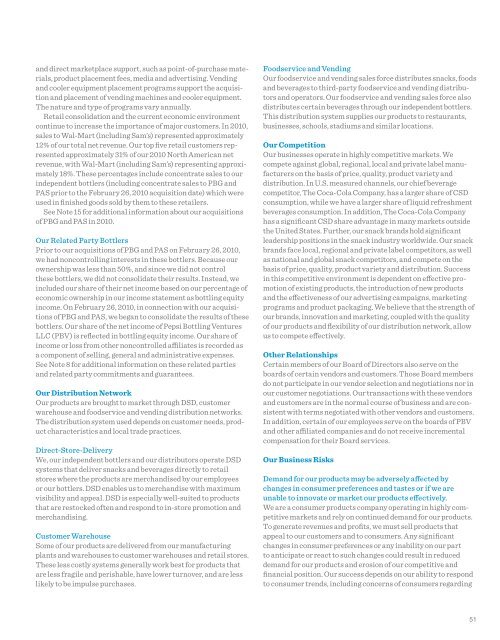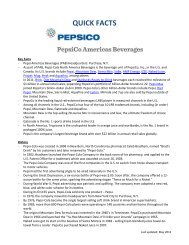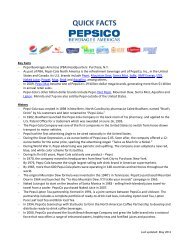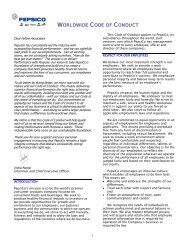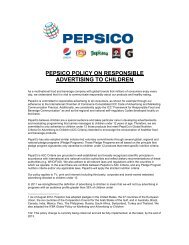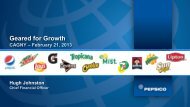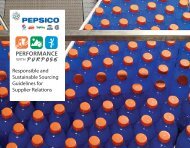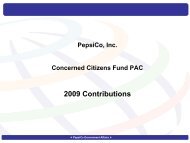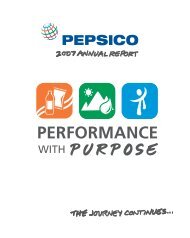Financials - PepsiCo
Financials - PepsiCo
Financials - PepsiCo
Create successful ePaper yourself
Turn your PDF publications into a flip-book with our unique Google optimized e-Paper software.
and direct marketplace support, such as point-of-purchase materials,<br />
product placement fees, media and advertising. Vending<br />
and cooler equipment placement programs support the acquisition<br />
and placement of vending machines and cooler equipment.<br />
The nature and type of programs vary annually.<br />
Retail consolidation and the current economic environment<br />
continue to increase the importance of major customers. In 2010,<br />
sales to Wal-Mart (including Sam’s) represented approximately<br />
12% of our total net revenue. Our top five retail customers represented<br />
approximately 31% of our 2010 North American net<br />
revenue, with Wal-Mart (including Sam’s) representing approximately<br />
18%. These percentages include concentrate sales to our<br />
independent bottlers (including concentrate sales to PBG and<br />
PAS prior to the February 26, 2010 acquisition date) which were<br />
used in finished goods sold by them to these retailers.<br />
See Note 15 for additional information about our acquisitions<br />
of PBG and PAS in 2010.<br />
Our Related Party Bottlers<br />
Prior to our acquisitions of PBG and PAS on February 26, 2010,<br />
we had noncontrolling interests in these bottlers. Because our<br />
ownership was less than 50%, and since we did not control<br />
these bottlers, we did not consolidate their results. Instead, we<br />
included our share of their net income based on our percentage of<br />
economic ownership in our income statement as bottling equity<br />
income. On February 26, 2010, in connection with our acquisitions<br />
of PBG and PAS, we began to consolidate the results of these<br />
bottlers. Our share of the net income of Pepsi Bottling Ventures<br />
LLC (PBV) is reflected in bottling equity income. Our share of<br />
income or loss from other noncontrolled affiliates is recorded as<br />
a component of selling, general and administrative expenses.<br />
See Note 8 for additional information on these related parties<br />
and related party commitments and guarantees.<br />
Our Distribution Network<br />
Our products are brought to market through DSD, customer<br />
warehouse and foodservice and vending distribution networks.<br />
The distribution system used depends on customer needs, product<br />
characteristics and local trade practices.<br />
Direct-Store-Delivery<br />
We, our independent bottlers and our distributors operate DSD<br />
systems that deliver snacks and beverages directly to retail<br />
stores where the products are merchandised by our employees<br />
or our bottlers. DSD enables us to merchandise with maximum<br />
visibility and appeal. DSD is especially well-suited to products<br />
that are restocked often and respond to in-store promotion and<br />
merchandising.<br />
Customer Warehouse<br />
Some of our products are delivered from our manufacturing<br />
plants and warehouses to customer warehouses and retail stores.<br />
These less costly systems generally work best for products that<br />
are less fragile and perishable, have lower turnover, and are less<br />
likely to be impulse purchases.<br />
Foodservice and Vending<br />
Our foodservice and vending sales force distributes snacks, foods<br />
and beverages to third-party foodservice and vending distributors<br />
and operators. Our foodservice and vending sales force also<br />
distributes certain beverages through our independent bottlers.<br />
This distribution system supplies our products to restaurants,<br />
businesses, schools, stadiums and similar locations.<br />
Our Competition<br />
Our businesses operate in highly competitive markets. We<br />
compete against global, regional, local and private label manufacturers<br />
on the basis of price, quality, product variety and<br />
distribution. In U.S. measured channels, our chief beverage<br />
competitor, The Coca-Cola Company, has a larger share of CSD<br />
consumption, while we have a larger share of liquid refreshment<br />
beverages consumption. In addition, The Coca-Cola Company<br />
has a significant CSD share advantage in many markets outside<br />
the United States. Further, our snack brands hold significant<br />
leadership positions in the snack industry worldwide. Our snack<br />
brands face local, regional and private label competitors, as well<br />
as national and global snack competitors, and compete on the<br />
basis of price, quality, product variety and distribution. Success<br />
in this competitive environment is dependent on effective promotion<br />
of existing products, the introduction of new products<br />
and the effectiveness of our advertising campaigns, marketing<br />
programs and product packaging. We believe that the strength of<br />
our brands, innovation and marketing, coupled with the quality<br />
of our products and flexibility of our distribution network, allow<br />
us to compete effectively.<br />
Other Relationships<br />
Certain members of our Board of Directors also serve on the<br />
boards of certain vendors and customers. Those Board members<br />
do not participate in our vendor selection and negotiations nor in<br />
our customer negotiations. Our transactions with these vendors<br />
and customers are in the normal course of business and are consistent<br />
with terms negotiated with other vendors and customers.<br />
In addition, certain of our employees serve on the boards of PBV<br />
and other affiliated companies and do not receive incremental<br />
compensation for their Board services.<br />
Our Business Risks<br />
Demand for our products may be adversely affected by<br />
changes in consumer preferences and tastes or if we are<br />
unable to innovate or market our products effectively.<br />
We are a consumer products company operating in highly competitive<br />
markets and rely on continued demand for our products.<br />
To generate revenues and profits, we must sell products that<br />
appeal to our customers and to consumers. Any significant<br />
changes in consumer preferences or any inability on our part<br />
to anticipate or react to such changes could result in reduced<br />
demand for our products and erosion of our competitive and<br />
financial position. Our success depends on our ability to respond<br />
to consumer trends, including concerns of consumers regarding<br />
51


